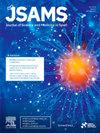Brachial arterial adaptations in college baseball players: Differences between pitchers and fielders
IF 3
2区 医学
Q1 SPORT SCIENCES
引用次数: 0
Abstract
Objectives
Although exercise-induced vascular adaptations have been extensively reported in racket sports athletes, the applicability of these findings to athletes in other overhead sports is unclear. This study aimed to investigate exercise-induced vascular adaptations in college male baseball players. Furthermore, since the training frequency of the upper arm may differ by baseball playing position, this study also focused on playing position-specific differences in brachial arterial adaptations.
Design
Cross-sectional study.
Methods
Seventy-five baseball players and 23 sedentary young men aged 18–23 years participated in this study. The participants' brachial artery diameter, blood flow velocity, and blood flow volume were measured using an ultrasonic diagnostic imaging system. Brachial hemodynamic measurements of both hands were obtained randomly in a seated resting position.
Results
Baseball players demonstrated significantly greater brachial lean mass, circumference, arterial diameter, and blood flow volume than sedentary control participants. Statistically significant differences in brachial artery diameters between the non-dominant and dominant arms were observed only in the baseball pitcher group. Furthermore, body surface area- and brachial lean mass-corrected artery diameters in the dominant arm were also significantly larger than those in the non-dominant arm in the baseball pitcher group. A simple correlation analysis revealed a positive association between brachial lean mass/circumference and arterial diameter in all participants.
Conclusions
These findings suggest asymmetrical exercise-induced vascular adaptations in the brachial artery of baseball players, particularly pitchers, indicating the potential role of playing position-specific demands in vascular remodeling. Understanding these adaptations may inform training strategies and help prevent injuries in baseball players.
大学棒球运动员的肱动脉适应:投手和外野手之间的差异。
目的:尽管在球拍运动运动员中运动诱导的血管适应已经被广泛报道,但这些发现对其他头顶运动运动员的适用性尚不清楚。本研究旨在探讨大学男棒球运动员运动诱导的血管适应性。此外,由于上臂的训练频率可能因打棒球的位置而异,因此本研究还侧重于臂动脉适应的打球位置特异性差异。设计:横断面研究。方法:75名棒球运动员和23名久坐不动的年轻人参与了这项研究,年龄为18-23 岁。使用超声诊断成像系统测量参与者的肱动脉直径、血流速度和血流量。双手的肱血流动力学测量在坐位时随机获得。结果:棒球运动员的臂膀瘦质量、周长、动脉直径和血流量明显大于久坐不动的对照组。非优势臂和优势臂臂动脉直径的统计学差异仅在棒球投手组中观察到。此外,在棒球投手组中,优势臂的体表面积和肱lean质量校正动脉直径也显著大于非优势臂。一项简单的相关分析显示,所有参与者的臂膀瘦质量/围度与动脉直径呈正相关。结论:这些研究结果表明,棒球运动员,特别是投手,臂动脉的不对称运动诱导血管适应,表明在血管重塑中发挥位置特异性需求的潜在作用。了解这些适应性可以为训练策略提供信息,并有助于防止棒球运动员受伤。
本文章由计算机程序翻译,如有差异,请以英文原文为准。
求助全文
约1分钟内获得全文
求助全文
来源期刊
CiteScore
7.40
自引率
10.00%
发文量
198
审稿时长
48 days
期刊介绍:
The Journal of Science and Medicine in Sport is the official journal of Sports Medicine Australia (SMA) and is an an international refereed research publication covering all aspects of sport science and medicine.
The Journal considers for publication Original research and Review papers in the sub-disciplines relating generally to the broad sports medicine and sports science fields: sports medicine, sports injury (including injury epidemiology and injury prevention), physiotherapy, podiatry, physical activity and health, sports science, biomechanics, exercise physiology, motor control and learning, sport and exercise psychology, sports nutrition, public health (as relevant to sport and exercise), and rehabilitation and injury management. Manuscripts with an interdisciplinary perspective with specific applications to sport and exercise and its interaction with health will also be considered.

 求助内容:
求助内容: 应助结果提醒方式:
应助结果提醒方式:


